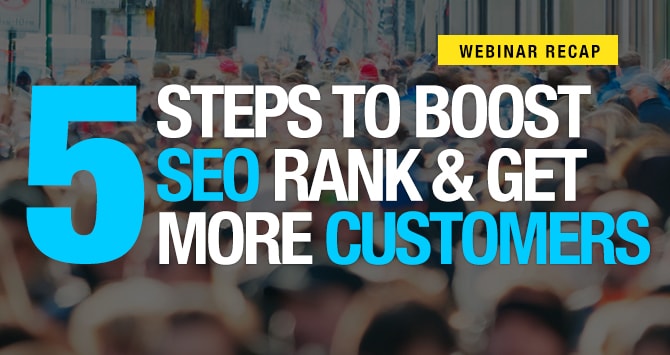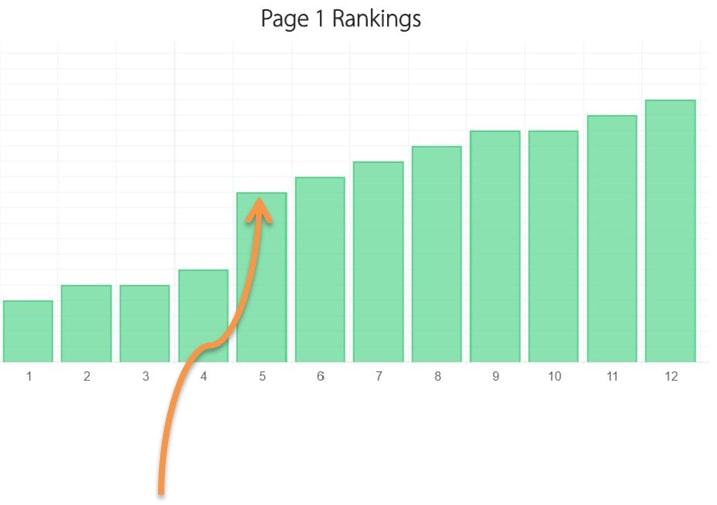Need more customers? Getting your business found on search engines by your target customers at the precise moment they’re searching for what you offer is one of the most effective ways to drive site traffic and revenue growth.
Research proves that 89.92% of people click on links on the first page of Google search results.
Competition for page-1 Google listings can be fierce. Google’s complex algorithm utilizes numerous factors to determine how high sites rank in organic search results. Effective SEO typically takes four to six months of work before the best results are achieved.
Our SEO company utilizes advanced technology and time-tested and proven techniques that often produce results within as little as 30 days. In this webinar, AIS Media CEO, Thomas Harpointner, explores some of the biggest SEO trends along with actions that have proven to drive substantial results for clients.
Our Five Step Process for Winning SEO
#1 Technical SEO: Auditing Your Site for Potential Violations
Sites with broken links, slow-loading pages, and other errors impede both Google SEO rankings and the user experience. This adversely affects conversion rates and revenue.
A technical SEO analysis summarizes the health of your site’s structural elements. Errors and warnings are often related to issues with H1 tags, image tags, broken hyperlinks, description length, etc.
An additional element to test is “mobile-friendliness”, which Google incorporated as a ranking signal. Sites that pass the mobile-friendly test receive a higher SEO rank in mobile search results.
Take Google’s mobile-friendly test to see if your rankings are impacted by a poor mobile site.
Reduce Your Site Speed
However, being “mobile friendly” or mobile compliant is only the first step towards ranking growth. Google also factors in a site’s speed or the time it takes to load a page when determining rankings.
There is no doubt that mobile users want to get to what they are looking for quickly and efficiently. With visitors consuming content and site data at a frenetic pace, every second counts.
Perform a website performance analysis on your highest traffic landing pages. There are many tools we use to analyze site speed here at AIS Media including Google Developers’ Page Speed Insights, Pingdom, and GTmetrix.
A technical SEO audit is a summary of your site’s speed on mobile and desktop, both major SEO factors. Errors and warnings often include issues with large image files, browser caching, server response time, and more.
Real Results from Minimizing Site Speed
After upgrading to a faster web host and compressing file sizes found on our own website, we saw an immediate rise in page 1 rankings. Site speed may be the only factor holding you back from page #1 rankings.
#2 On-Page SEO: Connecting Content with Keywords
On-page SEO is the process of optimizing your site so search engines can easily identify and classify it. Begin this step by researching your highest-value keywords to target before writing content or optimizing your metadata.
Your business is unique. You need to know how your customers are searching for the products and/or services that you offer. You may be surprised to find that your customers use queries that are much different than the language you use on your website.
It’s not always about getting visitors to your site, but about getting the right kind of visitors. Your keyword research must align with your business goals. If your aim is to drive sales, then find keywords that are nearest to the sale.
For example, if you build decks, “deck contractor” and “deck company” are phrases that demonstrate the buyer’s intent.
Long-Tail Keyword Research
During this exercise, you should also expand your research to long-tail keywords, or 3+ word phrases. Long tail keywords offer qualifying details about the products or services you offer. In general, long-tail keywords have lower search volume than their short-tail counterparts, but they often are a direct match for the visitor.
Due to lower competition, highly specific long-tail keywords tend to be easier to rank well for than short-tail keywords.
Tips for Writing and Optimizing Your Content for Keywords
- Start your title with your keyword. Your title is the most important on-page SEO factor. The closer to the front of the title your keyword is, the more weight it carries.
- Leverage multimedia. Images, videos, and illustrations increase audience engagement and reduce bounce rates.
- Drop your keyword in the first 100 words. Make sure your keyword appears in the first 100 words of your content.
- Use outbound links. Linking out to relevant sites helps search engines determine your site’s content and are proven to outrank pages without outbound links.
- Use internal links. Add 2-3 links to other pages within your site on every page.
- Length is strength. A Backlinko industry study found that longer content tends to rank higher on Google’s first page.
#3 Off-Site SEO: Finding High-Quality Backlinks
One of the most significant off-site SEO ranking factors is the volume of high-quality backlinks directed to your site. Search engines only give SEO value to backlinks considered to be from “high-quality” sources.
Off-site ranking factors help search engines index your content. Backlinks demonstrate user perception of a site’s popularity, trustworthiness and authority. Many businesses claim competitive advantages on their websites, but users often seek third-party validation for their claims. For this reason, when other “high-quality” sources promote your business, they express to users the quality of your products or services.
How Does Google Measure “High-Quality” Backlinks?
- Global Popularity: When high-profile sites link to your site, Google treats this with higher SEO value. A link from Wikipedia carries a lot of weight, since Wikipedia pages are read frequently. By contrast, a link from an obscure blog with few readers carries little weight.
- Topic-Specific Popularity: Links from sites with related content have an even greater weight on SEO ranks. If a local medical practice’s site gets a link from the American Medical Association, that’s considered a higher-value link than a link from a non-medical site.
- Anchor Text: This is one of the strongest indicators of a high-quality backlink. Send a strong signal to Google by pointing a link to your site using a related keyword as anchor text.
- Link Neighborhood: There are a lot of spam/low-quality links out on the web. Google determines that a site that links to spam is probably also spam. This creates a local network of sites, otherwise known as a link neighborhood. Search engines measure your link neighborhood to determine your rankings.
While Google’s algorithm changes daily, data from Moz’s Search Engine Ranking Factors supports that off-site SEO-related factors likely carry more than 50% of the ranking factor weight.
Yet, building a strong backlink profile can be one of the most difficult aspects of SEO. Each link-building campaign is unique and takes a lot of creativity. This process requires a strategy, reaching topically-relevant sites that could host a backlink.
Tips for Gaining High-Quality Backlinks
- Write thought-leading blog articles regularly
- Cover a single topic in-depth, with long-form content between 1,200 and 2,000 words
- Leverage social media to amplify the reach of your content
- Engage bloggers and your content for consideration
- Interact with targeted web communities by posting comments and creating profiles
#4 Local Listings: Improving Your Rank on Google Maps Results
Google Maps is a popular search interface. Customers check Google Maps for proximity searches, most commonly on their mobile devices. Local businesses have a competitive advantage by appearing in Google Maps results.
Local directory listings are an important local SEO ranking factor. Inconsistent, duplicate, or missing directory listings will negatively impact your ability to rank well in search engine results and local keyword rankings.
Make sure your business info is accurate by asking these questions:
- When people search for your business, does your phone number show up?
- Is the right address for each of your locations listed on your website?
- Does your business appear properly on all major directories?
How Google Determines Local Rankings
Google provides local businesses the three key ingredients that factor into your Google Maps placement. According to the local support guide, local results are based on relevance, distance, and prominence. Google uses machine learning to combine these factors to help find the best match for every search.
For example, if your business is further away from the searcher’s location, but you are more likely to have what they are looking for than a business that’s closer, Google will rank your business higher in local results.
Relevance
Relevance shows Google how well your local listing matches what users are searching for. Add complete and detailed business information across all major directories will help Google better understand your business and match your listing to relevant searches.
Distance
Distance is calculated in every search, representing how far each potential search result is from the location term used in a search e.g. “pizza in NYC”. If a user doesn’t specify a location in their search, Google will calculate distance based on what’s known about their location.
Prominence
The third factor, prominence considers how well-known a business is offline. This is where Google’s machine learning has to perform some investigative work to understand your business and your competitors.
Google calculates prominence using information about a business across the web, like links, articles, and directories. Your Google review count and star ratings are factored into local search ranking: generating more reviews and positive ratings will likely improve your local ranking.
Finally, your position in organic listings is also a factor for calculating prominence, so SEO best practices also apply to local search optimization. This means every step of our five-step process is vital for overall success in SEO.
#5 Social SEO: Harnessing the Power of Social Media for Search
Social media can be an effective way to promote your content online. Beyond generating buzz, engaging social content can: create brand credibility, build brand advocates and send signals of relevancy to search engines.
Leveraging social media content effectively can have a significant impact on rankings, traffic, and sales. Authentic interactions between a company and its customers online are hard to fake, especially on social media. A tweet that generates retweets or a Facebook post with shares, likes, and comments is unlikely to happen without an authentic relationship between a brand and its fan base.
For this reason, a high level of social sharing is a ranking signal in the Google algorithm. For positive social SEO, your social media profiles can impact your authority in search engine results.
Ratings and Reviews as a Ranking Factor
According to Moz’s Local Search Engine Ranking Survey, online reviews are thought to make up to 10% of how search engines rank sites. Your business needs positive ratings and reviews because Google Maps now features reviews prominently and ratings and reviews influence SEO rankings.
According to a BrightLocal survey, 92% of people read reviews to determine the quality of a local business.
Reviews across your social media profiles can influence a potential customer’s decision to work with you or your competitor. Because of this, Google places ranking importance on your online review profile.
Get our FREE SEO Analysis and see how your site stacks up against your competitors
Want to know how SEO-friendly your site is? How about how well it stacks up against some of your top competitors on Google? What specific steps need to be taken to increase SEO rank, site traffic, and conversions?
Get a free SEO consultation today now from our winning team. Our digital marketing experts are standing by to help you answer these questions and more. Contact us today by filling out our contact form, or giving us a call at 404.751.1043.


